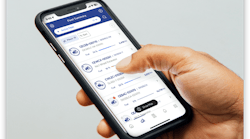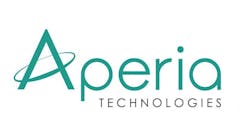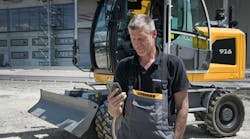Type the word “telematics” into the search box of Construction Equipment’s website, and 392 entries are available, with articles about the basic technology, columns by industry experts outlining efficiencies to be gained, and myriad press releases announcing new hardware and services. Easy to get the impression that the technology is so widely understood, accepted, and usefully employed, that there’s really nothing more to say.
But, based on conversations Construction Equipment has had with fleet owners, equipment manufacturers and dealers, and with third-party suppliers of telematics hardware and data-collector systems, it’s apparent that the use of telematics still ranges along a wide spectrum. At one end are non-users—probably still in significant numbers.
At the other end of the spectrum are fleets that are successfully integrating telematics data (usually very select data points and probably fewer than you’d think) into business-management software systems for the purpose of generating information that helps with such tasks as project billing, maintenance scheduling, utilization assessment, and machine-idling control. These users, over time, have expanded the use of data into company departments other than fleet management, and among their chief concerns today are data integrity and consistency, which they continuously monitor.
At the far end of the spectrum, too, are equipment dealers who are committing resources to monitor and evaluate information from customer machines, with the intent of catching the really important issues that threaten machine health and operator safety. They have the expertise to prioritize the flood of fault codes and alerts received, not bothering customers with non-essential information. Some machine owners recognize the value of this dealer service and refuse to do business with dealers not monitoring their customers’ machines.
Along the broad part of the spectrum are fleets of all sizes using telematics in any number of ways: to improve fueling operations by giving access to machine location and fuel-burn data to fuel jobbers; to prove a machine’s use on a job to skeptical project owners; to satisfy bid requirements asking for fuel-consumption figures; to simply pull in accurate hour-meter readings; or to track down the source of an excavator’s rapid undercarriage wear by using the wealth of machine-specific performance data available.
Attempting to quantify either the number of users in these categories or the data points they’re using is difficult. Taking the long view, however, the consensus seems to be that a growing number of off-road machine owners are more fully understanding the technology, but are still asking fundamental questions about how, specifically, the technology can work for them.
“Frequently today, companies are trying to figure out exactly what telematics data they really need,” says Tony Nicoletti, vice president, sales and business development at DPL Telematics. “That’s still one of the biggest challenges. Some needs are extensive with a very defined application, such as monitoring diagnostic fault codes for predictive maintenance or more-efficient in-field, single-trip service, while others are very basic.”
But the lure of big data—digital access to the immense number of facts that an on-board telematics system can generate—is still difficult for some machine owners to resist, reasoning that if a few data points are useful, then more are better.
“We sometimes hear contractors asking for as much data as they can get,” says Nicoletti, “but they don’t necessarily have a plan for how it will be used. There sometimes appears to be a desire for collecting more data just for the sake of having more data.”
Nicoletti adds, however, than when more information is legitimately required, the new 2.0 version of the AEM/AEMP standard, which allows an increased number of data points from multiple sources to be uniformly formatted and accessed via a single digital portal, will be of value. If, as expected, the International Standards Organization (ISO) approves the new standard, it will take on a global perspective that could potentially result in increased application of telematics data.
Tim Truex, mid-size equipment and electrical manager at Kokosing Construction, which has a fleet-wide telematics program using in-house processing servers, still cautions against the “more-data-is-better” mindset.
“In my opinion,” says Truex, “the application of so-called ‘advanced telematics’ will occur when the noise goes down and information being generated is pointing to exceptions that you can use to manage—rather than trying to ‘drink from the fire hose’ by attempting to assimilate all the data available.
“Many equipment-management practices can be accomplished, streamlined, and improved with just basic telematics data. Once the basics are in place, managing by exception and implementing more advanced data points and analytics will allow for a more proactive approach.”
The state of the technology
Ken Calvert, director, machine systems, Komatsu America Corp., also sees a downside to data overload.
“The elephant in the room being ignored is that no one is yet getting the value from telematics that could be received. The problem, in general, is that busy people are being asked to take on an extra task. These people, who have a long record of successfully managing equipment and already have a full plate, are being asked to dig into the mass of telematics data and search for the needle in the haystack—that bit of information that results in an ‘aha’ moment and saves the company lots of money. Telematics systems need to make things easier for people, not give them more to do.”
In Calvert’s opinion, telematics technology will make no significant advancement until pertinent data can be more simply and effectively automated into the fleet owner’s business-management systems. He thinks that a major equipment manufacturer—perhaps in partnership with a company having good connected-worksite technology—is in the best position to accomplish a more streamlined integration process. Such companies fully understand the practical concerns of machine management and job-site management, he says, and can guide data input and integration accordingly.
“Data must be embedded into back-office systems, and machine owners need to develop business rules that produce an actionable event to address what the data indicate,” says Calvert. “For example, if a company has policies limiting speed, or reverse operation, or idling, or excessive brake usage, then the system should ensure that each infraction uncovered by telematics be promptly addressed with an immediate coaching event.”
Machine health and fuel limits
Liz Quinn, product marketing manager, John Deere WorkSight, the company’s suite of solutions that includes JDLink telematics, also sees data integration as a key factor in the technology’s expanded application.
“As an industry, we need to bring clarity to data integration into business systems in order to make it an easier, more-achievable process for end users. The new AEM/AEMP standard could assist in this regard. At present, John Deere has a specialized group that coordinates with customers and qualified third-party data integrators to facilitate the process of using the standardized application-programming interface.
“These third-party data integrators include companies such as specialized portal providers, construction software firms, and back-office-system suppliers. By incorporating machine data, these applications deliver more insight about overall operations and key business- performance indicators to our shared customers.”
Among the most beneficial aspects of telematics today, says Quinn, is the technology’s capability to provide the comprehensive data needed to set reasonable fuel-burn standards for machines working across varied applications. Based on this information, a number of manufacturers, John Deere included, have developed programs that defray a portion of the machine owner’s fuel expenses if per-hour-consumption thresholds are exceeded.
Quinn also is of the opinion that today’s telematics systems have significantly increased the dealer’s ability to work on machines—efficiently—by allowing technicians to remotely access the machine’s computer to diagnose issues before the service truck leaves the shop. This capability is enhanced, says Quinn, with “threshold rules” that prompt action on the dealer’s part if certain machine parameters are exceeded, whether brake temperature, filter restriction, crawler reverse travel, or myriad other factors.
According to Christopher Seelan, president/CEO of Genesis Circle, a custom software development and design company, setting thresholds for machine performance, such as fuel burn, also can help identify underlying issues with machines and operators, especially when used in conjunction with additional telematics data. For example, a fuel-burn threshold for a mining truck, coordinated with tire-pressure data and load data, helps provide a comprehensive look at the overall operation of the truck.
“A sudden spike in fuel burn might indicate a change in operator behavior or a machine problem,” says Seelan, “while a steady increase in the burn rate might indicate that the machine needs maintenance. We can establish benchmarks based on OEM data and take action when they’re exceeded.”
More control, less paper
Kenneth “Mick” Lauer, project/account manager for OEM Data Delivery and former fleet manager for Bechtel, sees telematics systems advancing to a level of what he calls “operator and equipment management.”
The KeyPOD system developed by the company, says Lauer, has a keypad that communicates with the company’s MiniPOD data-transmission device to prevent unauthorized use of machines and to provide paperless inspection reports. The system requires an operator to enter an identification code, which, if not recognized as being that of an authorized user of that asset, will either keep the machine from starting or will illuminate a red light on the roof of the machine.
The system also allows the daily inspections required by OSHA for cranes, aerial lifts, and forklifts to be performed digitally, with the results transferred wirelessly to a server that can send data to the machine owner’s software system.
KeyPOD also allows required maintenance information to be entered and subsequent work orders to be generated.
“The system encompasses the entire aspect of operating a piece of equipment—from verifying the operator’s credentials, to safety inspections, to maintenance,” says Lauer. “I think this is where telematics systems are taking us at the moment.”
Inspections and integration
Craig Cutting, system application representative at Caterpillar, says the company has been testing its recently released electronic inspection program (Cat Inspect) for more than a year. The inspection “app” can be downloaded to any smartphone or tablet and uses model-specific inspection forms, which, says Cutting, can also be developed for non-Cat machines through Caterpillar dealers. Within the app, users can enhance inspections by typing or dictating notes, as well as by attaching photos or video.
Once completed, the inspections generate reports within the app, highlighting items that require attention. Important alerts are forwarded to Cat VisionLink, the Caterpillar telematics web-based interface, giving all those involved with fleet management an immediate view of critical-status updates.
“Electronic inspections get back into the maintenance manager’s view much quicker than using paper forms,” says Cutting. “No longer does the manager have to wait until the operator brings in the report—or hope that the handwriting is legible enough to read.”
According to Cutting, Caterpillar also has recently taken its telematics program in a new direction that will expand the company’s involvement in the technology of data management.
“Caterpillar has recently become a complete mixed-fleet provider,” says Cutting. “Without having to install our Product Link [the Caterpillar telematics system] box on a non-Caterpillar machine, we now have the capability to provide a one-source, mixed fleet solution for the customer—using other OEM and some third-party devices already onboard the machine and using their API feeds. That information funnels into VisionLink, so the customer has one login to see the entire fleet and the information that other OEMs using the AEM/AEMP standard are providing. We saw this as great need in the marketplace.”
Taking the long view of the state of telematics at present, Cutting makes several observations.
“It’s difficult to correlate the use of telematics to fleet size,” he says. “We have customers with one or two machines who are as heavily invested into telematics—understanding the value and benefits of the data and using it on a daily basis—as are some customers with hundreds of machines who are using it the same way.”
Whether or not machine owners are invested in telematics, says Cutting, all benefit in tangible ways from the technology.
“Telematics data is helping OEMs build better machines that address customer concerns,” he says, “and to proactively address machine issues before they develop into bigger problems—often doing so before the customer is aware that the machine needs attention. Telematics data is helping everyone, but we still need education about the technology. Equipment dealers generally are doing a good job at that.”





